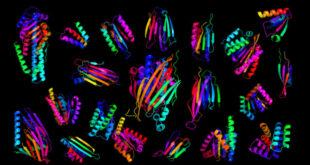Ajoene, an active sulfurous compound found in garlic, is able to destroy important components in the communication systems of Staphylococcus aureus and Pseudomonas aeruginosa, according to a University of Copenhagen-led study.
Garlic is rich in ajoene, allicin, and thiosulfinates — sulfurous compounds that can boost the immune system. Image credit: Thomas Ulrich.
“We really believe this method can lead to treatment of patients, who otherwise have poor prospects, because chronic infections like cystic fibrosis can be very robust,” said study lead author Dr. Tim Holm Jakobsen, a researcher in the Department of Immunology and Microbiology at the University of Copenhagen.
“Now we have enough knowledge to further develop the garlic drug and test it on patients.”
In the study, Dr. Jakobsen and co-authors documented ajoene’s ability to inhibit small regulatory RNA (sRNA) molecules in two types of bacteria: the Gram-negative Pseudomonas aeruginosa and the Gram-positive Staphylococcus aureus.
They found that ajoene lowered expression of two sRNAs, called RsmY and RsmZ, in Pseudomonas aeruginosa and the small dual-function regulatory RNA, RNAIII in Staphylococcus aureus, that controls expression of key virulence factors.
“The two types of bacteria we studied are very important,” Dr. Jakobsen noted.
“They actually belong to two very different bacteria families and are normally fought using different methods.”
“But the garlic compound is able to fight both at once and therefore may prove an effective drug when used together with antibiotics.”
Previous studies have shown that garlic appears to offer the most powerful, naturally occurring resistance to bacteria.
In addition to inhibiting the bacteria’s RNA molecules, ajoene also damages the protective slimy matrix surrounding the bacteria, the so-called biofilm.
When the biofilm is destroyed or weakened, both antibiotics and the body’s own immune system are able to attack the bacteria more directly and thus remove the infection.
The findings are published in the journal Scientific Reports.
_____
Tim H. Jakobsen et al. 2017. A broad range quorum sensing inhibitor working through sRNA inhibition. Scientific Reports 7, article number: 9857; doi: 10.1038/s41598-017-09886-8
 #Bizwhiznetwork.com Innovation ΛI |Technology News
#Bizwhiznetwork.com Innovation ΛI |Technology News




